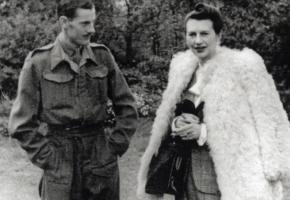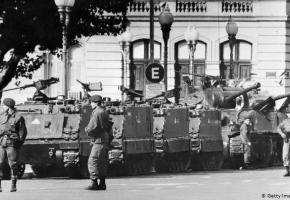The Mothers
Argentina’s ‘Dirty War’ created a new category of war victims; that of Los Desaparicidos (the Disappeared). These opponents of the 1976-1983 Argentine military junta were not killed in battle, assassinated or imprisoned. They were simply people (30,000 of them) who had apparently disappeared without trace. Some were Marxist or Peronist guerrillas fighting the military, but most were schoolkids, university students, factory workers, trades unionists, teachers, psychoanalysts, priests, and volunteers in shanty towns; anyone with left-wing ideas, or just suspected of being ‘subversive.’
Families lost members of all ages, but most of the Disappeared were between 17 and 27 years old. 30% were women. 80% were found to have no knowledge of subversive activity.*
In response to this phenomenon, Azucena Villaflor, a working class housewife from Buenos Aires, founded a unique organisation. On 13 April, 1977, she and 13 other mothers she’d met on her cruel pilgrimage round police stations and barracks, stood silently facing the Presidential Palace wearing white headscarves and holding photos of their disappeared children. The police moved them on, so they walked in a circle. ‘Las Madres de la Plaza d Mayo’ was born.
Under dictatorship surveillance, progress was slow. They almost faltered when later in 1977 Azucena herself was disappeared, together with two other founding mothers, and two French nuns who were supporting them. Despite this intimidation, more and more brave, desperate mothers joined them, and the few became the many. Foreign ngos helped them create data bases: from sightings of people in clandestine prisons; information smuggled out by sympathisers; even bragging by torturers. A profile of the repression in Argentina began to emerge. Although, at the time, the Mothers did not realise the scale of the sinister international state terror network that Argentina was part of. Known as Operation Condor, it enabled death squads from 8 Latin American dictatorships to cross borders to share intelligence, swap prisoners, and kidnap with impunity.
When Argentina returned to democracy in 1983, the information collected by the Mothers over the six years proved invaluable to the National Commission for the Disappearance of Persons (CONADEP) set up by the incoming civilian president Alfonsín. It’s report ‘Nunca Más’ (Never Again) helped a court sentence nine members of the junta to life imprisonment in1985.
Sadly, despite their slogan “You took them alive,we want them back alive”, few of the Mothers’ children reappeared. Searching for their remains became their next big task. It was hindered by the junta’s cruel policy of disappearing corpses as well. Many victims of the Army’s Campo de Mayo base, the Navy Mechanic’s School (ESMA), and the 300 clandestine torture centres around Argentina, were either drugged or shackled to concrete blocks and thrown out of planes into the sea. Fortunately for identification purposes, some later washed up in the River Plate estuary or on beaches of the Atlantic coast. Mass graves were gradually unearthed, the largest - in Córdoba - contained 700 corpses. Through the hard work of scores of forensic anthropologists, national and foreign, and improved forensic techniques, thousands of the Disappeared were eventually identified.
Even after years of work, hope and grief, the Mothers had another fight on their hands: persuing justice through the courts. They suffered a major blow when the life sentences given to the junta in early 1985 were commuted by President Alfonsín later in the year, due to fears of a military uprising. Worse was to come. They were pardoned by his successor President Menem in 1990. Menem offered compensation payments but many Mothers refused them until justice was done.,,,
Only when President Nestor Kirschner’s Peronist government came to power in 2003 were the Amnesty Laws derrogated. Only then could the Mothers’ law suits start to be brought against their childrens’ torturers and murderers. To date, 818 people, military, pólice and civilian, have been convicted of crimes during the Dirty War, with another 754 still on trial in Argentine courts. The defendents are by now very old, but still unrepentent.
And the Mothers still campaign for human and civil rights. Their legacy are the many ‘Madres’ organisations that have mushroomed all over Latin America and on other continents. The now famous white handkerchief is a symbol of hope and peace everywhere.
*declassified US State Department document 1979
** Operation Condor, by Giles Tremlett: Guardian Long Read Sept 2, 2020
Argentine feature films about this subject and period
La Historia Oficial directed by Luis Puenzo (1985) Oscar for best foreign language film
La Amiga directed by Jeanine Meerapfel (1988)
Un Muro de Silencio directed by Lita Stantic (1993)
Garaje Olimpo directed by Marco Bechis (1999)
El Secreto de sus Ojos directed by Juan José Campanella (2009) Oscar for best foreign language film
The Grandmothers
In 1977, Chicha Mariani, already a member of the Madres de la Plaza de Mayo, set up another organization to confront an equally cruel and unique crime: the theft of children. The previous year, Chicha’s daughter-in-law Diana had been killed in an army attack on the house in La Plata where she lived with Chicha’s son, a Montonero militant. Their three month-old baby Clara was beside her. Her attackers abducted the baby. Chicha’s group gradually swelled by other mothers whose daughters had either been kidnapped together with their toddlers, had been pregnant when abducted, or were impregnated by their torturers. They became the ‘Grandmothers of the Plaza de Mayo’.
The search for their grandchildren began. It soon became known that many had been adopted by military families or others who could be relied on to bring them up ‘correctly’; a way of eliminating a posible new generation of ‘subversives’. Chicha learned from a Catholic bishop that Clara was alive. But the Church refused to intervene. At first the painstaking detective work fell on the Grandmothers themselves: looking into adoption statistics; visiting orphanages and juvenile courts; following tip-offs from the public. A data base called The Grandparent Index was created. It held details of over 500 disappeared grandchildren.
Eventually DNA science came to the rescue. In 1984, the Grandmothers turned for help to U.S. geneticist Mary-Claire King, who in 1984 worked with Argentine colleagues to identify by genetic analysis the first confirmed stolen child. She later developed a system using mitochondrial DNA, which is inherited only from mothers, to identify individuals. In 1987 the Grandmothers’ prodded officials in the post-dictatorship era to pass a law formally creating Argentina’s National Genetics Bank, the first of its kind in the world, a breakthrough advance in DNA identification.
While the Grandmothers originally did the sleuthing, over the decades the ‘grandchildren’ also came looking. Aided by huge publicity about ‘found’ children, youngsters who for one reason or another felt uncomfortable at home or had doubts about their origen could deposit blood simples or look at the photo database. If they saw women who looked like them, and dates coincided, a DNA match from the gene bank could now prove it.
Initially the Grandmothers’ initial goal was to find the adopted children and restore them to what was left of their birth familes. But reactions of ‘found’ children varied. Some children accepted their dead parents’ families, and sometimes changed their names. Others refused to take the test, or were forbidden to by their adoptive parents to do so. Some were happy with the only parents they’d ever known, but acknowledged the pain of their birth family. Where there was no criminal intent (where a court case would ensue) links between birth families and foster families could be made. In contested cases, the law had to intervene, as in the notorious case of the children of the owner of the newspaper group Clarín.* This and many stories are astonishing.**
The one thing in the Grandmothers’ favour was a loophole in the Argentine Amnesty Laws: they did not cover the theft of babies. It was possible to prosecute both the intellectual authors of the crime, and the complicit adopters. Army officers and others were found guilty and jailed; moreso after the prorogation of the laws.
Time is not on the Grandmother’s side, however, all are in their 80s. Chicha Mariani died without finding her granddaughter Clara. But the third president Estela de Carlota found her grandson Guido in 2014 after 34 years of searching. The boy, now a man called Ignacio, walked into the Grandmothers’ office after hearing what he had originally thought was gossip. He took the DNA test and became the 114th grandchild to be found. He is a musician like his father.
The total now is 127.
*‘Children of the Dirty War’ by Francisco Goldman in The Newyorker
**Quién Soy? (Who am I?) documentary directed by Estela Blanco
Both the Mothers and Grandmothers achieved worldwide acclaim and recognition for theor bravery, their measures becoming a model of successful non-violent resistence. The pop star Sting wrote a song about them and in 1988, when the whole horror of what had happened truth was still being denied and had yet to fully come out, he sang this song in concert in Buenos Aires' River Stadium along side Peter Gabriel and invited the mothers and grandmothers onto stage.



















